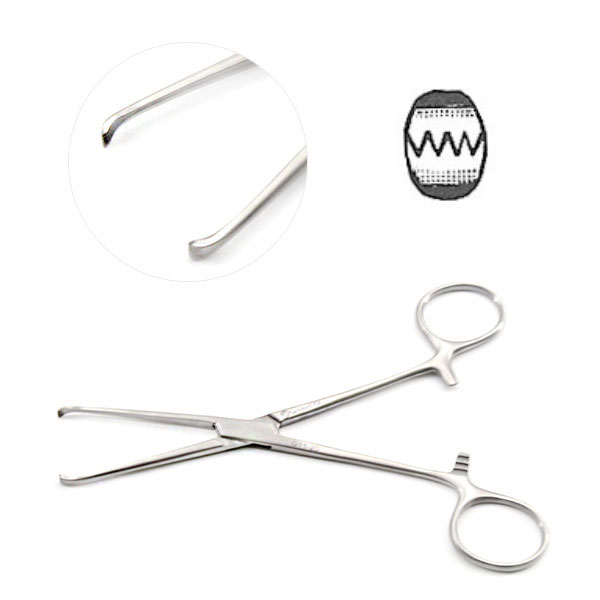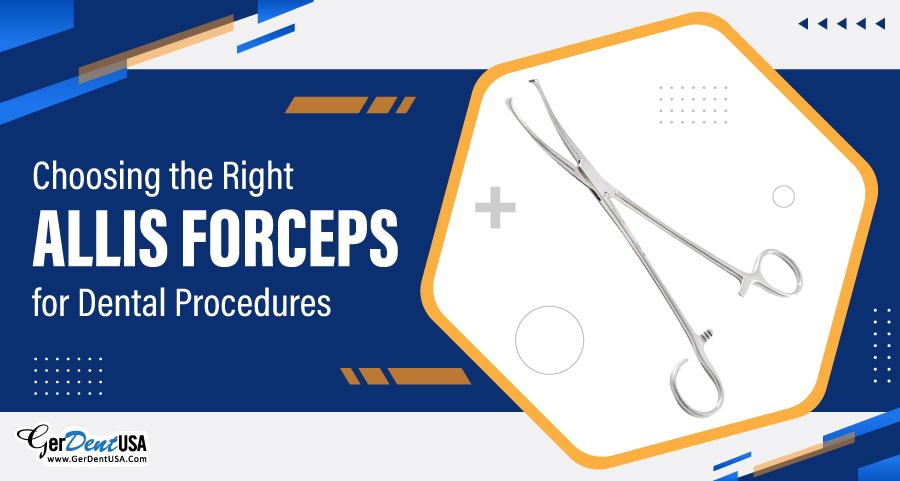When it comes to dental procedures, having the right tools at hand is crucial for ensuring successful outcomes. One such indispensable instrument is the Allis forceps.
These forceps come in various sizes and designs to accommodate different dental procedures.
Primarily, they help dentists provide a secure grip on tissues during tooth extraction or tissue manipulation.
However, selecting the appropriate Allis tissue forceps can be daunting, considering the numerous options available in the market.
This blog will enlighten you on what to consider when choosing these dental forceps to ensure effective oral procedures.
But first, let’s overview the basics of the instrument!
Understanding Allis Forceps
These forceps are commonly used in dental procedures to provide a secure grip on tissues.
Understanding their design and variations is essential for choosing the right variation for a specific dental procedure.
Structure and Functions
Allis forceps, also known as tissue forceps or surgical forceps, are handheld instruments with a scissor-like design.
They feature serrated jaws with interlocking teeth that firmly grip soft tissues, such as gums.
These ergonomic design forceps allow the dentist to exert controlled traction and manipulation without causing excessive trauma to the surrounding tissues.
Common Variations
The most common variations of these dental forceps are as follows.
Straight Pattern
This variation of Allis tissue forceps has straight pattern jaws, making it suitable for general use in ora procedures.
It has common use in
- Dental extractions
- Tissue manipulation
- Suturing procedures
Curved Pattern
Curved Allison forceps have jaws, allowing better access to hard-to-reach areas in the oral cavity.
These forceps are often used during posterior tooth extractions and oral surgeries where the dentist needs to navigate around anatomical structures.
Toothed vs. Non-toothed Allison forceps:
Allis dental forceps are available with or without teeth on their jaws.
Toothed forceps provide a stronger grip on tissues, making them ideal for cases requiring a secure hold.
Non-toothed forceps, on the other hand, are helpful in holding delicate tissues, reducing the risk of damage.
Allis-Coakley Tonsil Forceps
This variation is used to grasp and remove tonsils during a tonsillectomy procedure.
These forceps are named after their inventors, Edward Francis Allis and William Henry Coakley.
Allis-Coakley tonsil forceps have a slender finger ring handle with elevated, toothed jaws to help grip the tonsils firmly.
Allis-Coakley tonsil forceps are primarily used to grasp the tonsils and pull them out of the mouth.
In addition, these are helpful in packing the tonsillar fossa and catching bleeders.
Factors to Consider When Choosing Allis Forceps
Several factors should be considered when selecting Allison forceps for dental procedures.
Size and length of the forceps
Allison forceps come in various sizes and lengths to accommodate different dental anatomical structures and clinical scenarios.
So choosing the appropriate size ensures optimal grip and maneuverability during the procedure.
Material and quality
Dental professionals should opt for high-quality Allis forceps made from durable materials like stainless steel.
Quality instruments offer better performance. Plus, they can withstand repeated sterilization without compromising their integrity.
Handle design
Ergonomically designed handles with a non-slip grip reduce hand fatigue and enhance precision.
So always consider the design of the forceps handle as it determines the degree of the dentist’s hand control during the procedure.
Jaws design:
The forceps jaws should provide sufficient grip and control to securely hold tissues without slippage.
The interlocking teeth on the jaws should be sharp and properly aligned to ensure an effective grip.
Sterilization Compatibility:
Instruments incompatible with your sterilization protocols may deteriorate or become less effective over time.
Therefore, you must ensure that the forceps you choose can withstand the sterilization methods used in your dental practice.
By considering these factors, dental professionals can select Allis forceps that best suit their specific procedural needs, enhancing their efficiency and patient care.

Different Dental Procedures and Corresponding Allis Forceps
Allis forceps are utilized in various dental procedures to facilitate efficient and controlled tissue manipulation.
So choosing the appropriate variation for specific dental tasks is crucial for achieving optimal results.
In the Extraction of Anterior Teeth
Suitable Allis forceps for incisors
When extracting incisors, straight Allison forceps are commonly used.
Their straight jaws allow for a secure grip on the tooth, facilitating controlled extraction without excessive force or trauma to surrounding tissues.
The non-toothed variant is preferable to minimize damage to delicate incisor roots.
Suitable Allis dental forceps for canines
With their longer roots and more robust structure, canine teeth may require curved Allis forceps for extraction.
The curved jaws enable better access and manipulation in the posterior areas of the oral cavity.
In the Extraction of Posterior Teeth
While extracting different posterior teeth, the following variations of Allis forceps are used.
For premolars extraction
Premolars often have multiple roots and may necessitate toothed Allison forceps for a secure grip during extraction.
The interlocking teeth on the forceps' jaws enhance grip, allowing controlled and efficient removal of premolars.
For molars extraction
Molar teeth, known for their complex anatomy and multiple roots, require specialized Allis tooth forceps.
Curved variations with toothed jaws are suitable for molars, enabling optimal access and manipulation in the posterior regions of the mouth.
The curved design aids in navigating around adjacent teeth and anatomical structures, facilitating the extraction process.
Other Dental Procedures Requiring Allis Forceps
The other dental procedures that require these special dental forceps are as follows:
Biopsy
Allis forceps are instrumental in performing biopsies.
The ergonomic design of these forceps helps securely grasp and hold soft tissue specimens and allows for precise and controlled tissue sampling.
Toothed or non-toothed forceps may be used depending on the tissue's texture and fragility.
Retrieval of foreign objects
Allison forceps with toothed jaws are effective in removing foreign objects, such as broken dental instruments or small fragments from the oral cavity.
The interlocking teeth assist in securely grasping and retrieving foreign objects without causing additional harm.
Soft tissue manipulation
Allis tissue forceps are useful in various soft tissue manipulation procedures, such as retraction of flaps during surgical interventions or suturing.
The forceps' strong grip and controlled traction enable precise tissue manipulation, aiding in achieving optimal surgical outcomes.
Tips for Proper Use and Maintenance of Allis Forceps
To ensure the longevity and effectiveness of the forceps, it is essential to follow proper usage and maintenance guidelines, such as:
Sterilization protocols
It’s essential to adopt recommended sterilization protocols to eliminate the risk of infection and cross-contamination while reusing the instruments.
The best practice is to follow the manufacturer's instructions.
This would help follow appropriate sterilization methods, such as autoclaving or chemical disinfection.
Correct gripping techniques
Familiarize yourself with proper gripping techniques to maximize control over the instrument and minimize accidental trauma.
Hold the forceps with a firm yet comfortable grip, allowing for precise manipulation and avoiding excessive pressure.
Regular cleaning and maintenance
It’s essential to thoroughly clean the forceps after each use. This would remove any debris or organic material.
Use a mild detergent and a soft brush to clean the jaws, ensuring all surfaces are adequately cleaned.
Properly rinse the forceps and dry them before storage.
Proper storage to prevent damage
Store Allis forceps in a clean and dry environment, protected from moisture and physical damage.
Consider using a special instrument tray or container to prevent accidental damage or contamination.
By following these guidelines, dental professionals can ensure the optimal performance and longevity of any kind of dental forceps.
Moreover, they can enhance their clinical practice and patient care.
Wrapping Up!
With the right Allis forceps in hand, dental professionals can perform procedures effectively and deliver optimal patient care.
So, it’s important to select the right forceps by understanding and considering essential factors, as discussed above.
If you need any kind of dental forceps, whether tissue forceps or extraction forceps, we have all of them in multiple variations.
Besides, at GerDentUSA, we have been manufacturing and supplying all dental surgical instruments over the past three decades.
FAQs
What are our Allis forceps made of?
We manufacture our dental forceps and all other instruments from medical-grade German stainless steel. This high-quality material makes our tools high-tensile and autoclavable for reuse.
Why buy from us?
We have over thirty years of experience in manufacturing dental instruments. We closely work with dental professionals and design and craft our instruments accordingly.
Does GerDentUSA has customization facility?
We are open to customizing our instruments as per the demands of dental professionals.

